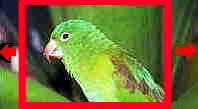|
Updated: 06/28/2005
World Television Standards and HDTV
Part II The 2004-2005 broadcast season was the first one in which the major networks broadcast live programming in HDTV. Although consumers were at first slow to make the investment in HDTV receivers, by 2005 this move had greatly accelerated. Sports programming was a major driving force. Once views saw the difference between SDTV and HDTV, the "need" was generated.
Compare the screen enlargements shown here that represent HDTV and the standard NTSC systems. (Note: When you move back from the screen to a distance approximating normal TV viewing distances, the differences between these photos are not nearly as obvious.) When projected on a 16- by 9-foot screen and observed from
a normal viewing distance, the picture detail in HDTV/DTV appears to
equal what is normally attained by projected 35mm motion picture film. The relative pixel detail of SDTV and HDTV is illustrated on the left. (These illustrations assume a 40-inch TV screen.) SDTV produces an image with about 200,000 pixel (picture) points. HDTV increases that by a factor of 10 to about two million pixels. In the
graph on the right note that the interlaced (i) and If we go on to compare the number of scanning lines, which here ranges from SDTVs 480 lines to HDTVs 1080 lines, the difference in sharpness becomes even more dramatic. The "pure" 1080p system (as opposed to the compromised hybrid system) delivers the maximum picture detail approved for broadcast. Although this approach is technically demanding, video recorded in this process is so sharp it can be converted to film and projected in a theater without patrons realizing they are seeing video. Comparisons between video and film quality are often made. But video and film are inherently different media and the question of their relative "quality" (a word which can mean many things to many people) has been the subject of lively debate. Both sides claim their medium is superior. Suffice it to say, when the film and video media are compared in a broadcast application, the difference between video and film is based more on the differences in their traditional production approaches than on any inherent quality differences between the media. The relative advantages of film and video and the differences
between their quality and costs are discussed in more detail The conversion of 16:9 HDTV/DTV images to the standard 4:3 aspect ratio is done by production facilities in basically the same way as the conversion of wide-screen films to NTSC television. (In-set conversion approaches will be covered later.) Production facilities use three approaches. First, in the "conversion" of 16:9 to 4:3 the sides of the picture can be cut off. This is referred to as an edge crop or a 4:3 center cut. If the original HDTV/DTV (or wide-screen film) is shot with the narrower 4:3 cutoff area in mind, losing the information at the sides of the picture may not be a problem. (This would be the area to either side of the red box in the photo below.) The procedure of keeping essential subject matter out of
the areas that will be Second, the entire production can go through a process called pan-and-scan. This involves a technician reviewing every scene and programming a computer-controlled imaging device to electronically pan the 4:3 window back and forth over the larger, wide-screen format. This panning movement is suggested by the arrows above. In the parrot picture above cutting off the sides would not be an issue; but, if you had two parrots talking to each other (??) from the far sides of the screen, it would be. Finally, if the full HDTV/DTV
frame contains important visual information (as in the case of written
material extending to the edges of the screen), But, as you can see, there is a problem. The result is blank areas at the top and bottom of the frame. Often, in these conversions the letterbox approach is reserved for the opening titles and closing credits of a production, with the remainder of the production being panned-and-scanned. Since some directors feel that pan-and-scan introduces pans that are artificial and not motivated by the action, they may try to insist that their work be displayed using letterbox conversion. Originally, producers feared that audiences would object to the black areas at the top and bottom of the letterbox frame. (More than one person who rented a film in the letterbox format brought it back to the video store, complaining that something was wrong with the tape.) However, today the letterbox format is commonly seen and accepted. For short segments of a production there is another way of handling the 16:9 to 4:3 aspect ratio difference. You have probably seen the opening or closing of a film on television horizontally "squeezed" to accommodate the titles and credits. This optical technique is referred to as anamorphic conversion.
The effect is especially noticeable when people are a part of the scene-people who, as a result, suddenly become rather thin. (Not that all actors would complain!) Compare the two images above. Note how the bird in the squeezed 4:3 ratio on the right seems to be thinner than the bird in the image on the left. Another way of visualizing the major
SDTV-to-HDTV and HDTV-to-SDTV conversion approaches is illustrated
HDTV receivers can also (roughly speaking) convert SDTV (4:3) and HDTV (16:9) aspect ratios. There are three options that are built into many HDTV receivers.
Clearly, all of these approaches leave something to be desired, so today savvy producers originate productions in the 16X9 wide-screen format.
Star Wars: Attack of the Clones, which was projected in its digital form in more than 90 theaters around the world, was shot entirely on 24P video (which we covered earlier). Whereas film and processing would cost several million dollars, the cost of videotape for this production was only about $15,000. With digital cinema there are also other cost savings. Each year the motion picture industry spends almost a billion dollars duplicating films and distributing them to theaters around the U.S. and the world. Films have limited life; they collect dirt and scratches, and soon have to be replaced. With video this billion-dollar figure can be cut to a fraction of this amount by using a central satellite location to uplink theatrical releases to theaters as they are needed. With so many copies of films being created, pirating (creating
and selling illegal copies) is a constant problem-one that has cost the
motion picture industry billions of dollars in lost revenue. Pirating
feature films is far more difficult when they are encrypted and sent
directly to theaters via satellite. The issue of pirating is discussed
in more detail In addition to cost savings, there are production advantages in digital cinema. After a scene is shot in video it can be immediately played back and evaluated-even while the actors and production personnel are still in position. The hours of delay involved in processing and preparing film "rushes" (rough prints for quick screening) does not make this possible. Today, most film directors use video assist, which means scenes are shot on film and simultaneously viewed and recorded on video, so they can be immediately evaluated. Finally, not only are postproduction costs far less with video, but special effects can be much more easily and inexpensively produced. There are also advantages for theaters in switching over to digital projection equipment. In addition to showing feature films, these theaters can provide patrons with digital feeds of live concerts, Broadway shows, sporting events, productions aimed at special audiences, etc. Digital theaters can be operated and maintained with fewer employees, which represents a considerable cost savings over time. However, offsetting this is the initial investment for digital projectors and the associated computer-an estimated $60,000 to $120,000 per screen. Even so, digital cinema amounts to a totally new technology and theater owners have for decades been using (and have grown comfortable with) the same basic approach to showing films. And then there is the issue of the investment involved. Even though both the number of screens and box office ticket revenues have increased steadily over the past five years, because of the high level of debt incurred from building additional megaplexes, plus the downturn in the economy that started in 2000, overall revenue for all four of the biggest theater chains has been dropping. Year 2005 figures even showed a drop in theater attendance. This was due to a number of factors: complaints about the "theater experience" (noisy patrons, etc.) the commercials being shown before films in some theaters, and the cost of gasoline for getting to theaters. Cable and satellite services that offer films from services such as HBO and Showtime seem to be benefiting.
Information on film revenues, the top grossing films,
and the future of motion pictures can be If you want a more detailed look
at the various DTV and high-definition standards in the United States,
including those being used for digital cinema |



 progressive
(p) approaches to scanning result in a significant difference in apparent
picture sharpness (measured in terms of discerned pixel points of detail).
progressive
(p) approaches to scanning result in a significant difference in apparent
picture sharpness (measured in terms of discerned pixel points of detail).  cut
off is referred to as shoot-and-protect. In this
photo this would mean anything to the left or right of the red box.
cut
off is referred to as shoot-and-protect. In this
photo this would mean anything to the left or right of the red box.  panning-and-scanning
will not work. In this case a letterbox approach
is used as shown here.
panning-and-scanning
will not work. In this case a letterbox approach
is used as shown here. 

 In
November, 2000, the film Bounce was released to theaters in both
film and high-definition video versions. The video version was distributed
to digitally-equipped theaters via satellite. These theaters used new
high-definition video projectors. The difference between the film and
video versions was difficult for audiences to discern. Major improvements
have been made in the process since then.
In
November, 2000, the film Bounce was released to theaters in both
film and high-definition video versions. The video version was distributed
to digitally-equipped theaters via satellite. These theaters used new
high-definition video projectors. The difference between the film and
video versions was difficult for audiences to discern. Major improvements
have been made in the process since then. 